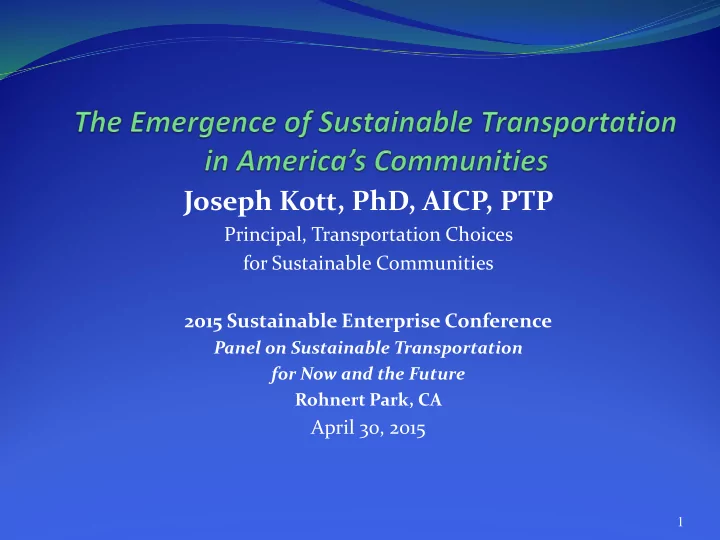

Joseph Kott, PhD, AICP, PTP Principal, Transportation Choices for Sustainable Communities 2015 Sustainable Enterprise Conference Panel on Sustainable Transportation for Now and the Future Rohnert Park, CA April 30, 2015 1
Sustainable Transportation: Images from Across America 2
What Does Sustainability Mean? Sustainability creates and maintains the conditions under which humans and nature can exist in productive harmony, that permit fulfilling the social, economic and other requirements of present and future generations. US EPA 3
What Makes Transportation Sustainable? is affordable, operates efficiently, offers choice of transport mode, and supports a vibrant economy; and 4
What Makes Transportation Sustainable? limits emissions and waste within the planet’s ability to absorb them, minimizes consumption of non- renewable resources, … and minimizes the use of land and the production of noise. 5
Our Unsustainable Transportation System 6
The Historical Rising Tide of Private Motor Vehicles 7
Demand Outpacing Road Supply 9.0 3.5 Millions Trillions Lane Miles 3.0 8.0 2.5 Vehicle Miles of Travel (VMT) 7.0 Public Road Mileage 2.0 Vehicle Miles of Travel 6.0 1.5 5.0 1.0 Public Road Mileage 4.0 0.5 3.0 0.0 Year 8
US Private Motor Vehicle Dependence/Dominance: 2009 9
Dominance of Private Motor Vehicles in the Commute Market 10
Less Automobile Dependence? 11
Environmental Impacts Photochemical smog Greenhouse gas (ground level ozone) emissions linked to climate change Particulate matter Damage to flora, fauna, Water pollution by public health, personal motor fuels, lubricants, health brake lining particles 12
Health Effects Human cardio- pulmonary health (especially young children, seniors, and those with asthma, emphysema, bronchitis) Health effects of sedentary lifestyles in young and old, including Type II diabetes 13
California Greenhouse Gas Emissions Shares: 2008 14
Effects of Increased Greenhouse Gases Emissions Worldwide Increased global temperatures over time Ice cap melts in Antarctica, Greenland, elsewhere Rising sea levels Displacement of people, economies Uncertain, potentially catastrophic climate effects – with detrimental impacts on people, economies, plants and animal life worldwide 15
A Checklist for Sustainable Transportation Retrofit communities for bicycling & walking 1. Integrate land use and transportation 2. Restore effective local & regional rail networks 3. Clean up motor vehicle fleets & increase average 4. vehicle occupancy Re-purpose street space on major streets for 5. public transit (bus lanes, light rail, BRT), bicycles, and pedestrian Re-purpose freeway rights-of-way to carry more 6. people, not just more motor vehicles 16
Steps in the Journey Toward Sustainable Transportation 17
The Broader Context: Complete Communities Characterized by A rich land use mix (housing, retail, office) in walking, bicycling, and short vehicle trip distance A generational mix Accommodation for all physical abilities Affordable housing options Transportation choices 18
The Broader Context: Complete Communities 19
More People in the Vehicles and Within the Right of Way 20
Case Study in Sustainable Transportation: New York City The Big Apple: Car Space Added 50 + pedestrian to Pedestrian Space plazas by converting 26 acres of car lane space to people space 30 between 2007 and 2012
Case Study in Sustainable Transportation: New York City The Big Apple as Added 350 + miles of Bicycling Mecca! bike lanes, 30 miles of parking protected bike lanes between 2007 and 2012 Installed 6,000 City Bikes in 330 bikeshare stations citywide 36,000 bikeshare users on an average day
Case Study in Sustainable Transportation: New York City Bus Priority in the Big Added 57 miles of Apple dedicated bus lanes, and 6 bus rapid transit (BRT) lines between 2007 and 2012
Case Study in Sustainable Transportation: The Atlanta, Georgia Beltline Atlanta’s “Un - highway” Plan to transform former circumferential rail line Creation of 33 miles of multi-use paths connecting neighborhoods, parks, business districts Longer-term plan for streetcar or light rail segments next to trail
Case Study in Sustainable Transportation: The Atlanta, Georgia Beltline Atlanta’s “Un - highway”
Case Study in Sustainable Transportation: The Indianapolis, Indiana Cultural Trail Indy Bikes and Walks An 8-mile pedestrian and bicycle path and greenways in and near downtown Connects six cultural districts Contains 25,400 square feet of storm water planters, 7 public arts projects, 26 bikeshare stations with 250 bikes
Case Study in Sustainable Transportation: The Indianapolis, Indiana Cultural Trail Indy Bikes and Walks
Case Study in Sustainable Transportation: Portland, Oregon 319 miles of bikeways (59 Portland’s Sustainable miles of neighborhood Transportation greenways, 79 miles of paths, 181 miles of bike lanes) 17,000 daily bike commuters; 6% of all Portland Commuters
Case Study in Sustainable Transportation: Portland, Oregon Portland’s Sustainable Transportation
Case Study in Sustainable Transportation: Portland, Oregon 4 light rail lines with Portland ’ s Sustainable 50.9 miles of route; a 7.3 Transportation mile line under construction 2 streetcar lines with 7.2 miles of route 79 bus routes 12% of Portland commuters use public transit
The “ Sharing Economy ” Bikeshare 31
The “Sharing Economy” Carshare 32
The “ Sharing Economy ” Sharing Streets “Sunday Streets”, Street Festivals, Marathons, etc. 33
The “Sharing Economy” Sharing streets Complete streets 34
The Renaissance of Urban Bicycling 35
The Revival of Public Transportation 36
The Renaissance of Urban Rail 45 Light rail or street car systems in the US 8 more currently under construction Only 8 operating in 1980! 37
The Emergence Of Bus Rapid Transit (BRT) Inspired by Curitiba, Brazil (1974) Wide variation in how “BRT” is implemented 33 BRT systems in the US in 2014 Many more in planning stage Only 2 prototypical BRT systems operating in 1980! 38
What Role For the Car? Downsize (smart cars, micro vehicles, small electric cars) for short tips? 39
What Role For the Car? Electric, hybrid/electric SUVs, pick-up trucks, standard size cars for longer trips, carrying passengers, hauling cargo 40
What Role For the Car? Car share/ ” car shed ” ? Lease only the portion of car use you need when and where you need it (the “ low car diet ” ). Reduces household car ownership (about in half in a 2010 study), makes car use pricing more transparent 41
Questions? Joseph Kott, PhD, AICP, PTP JKott@Transportchoice.org 42
Recommend
More recommend